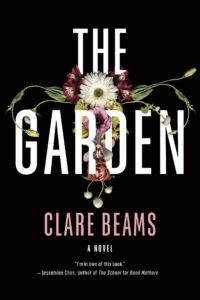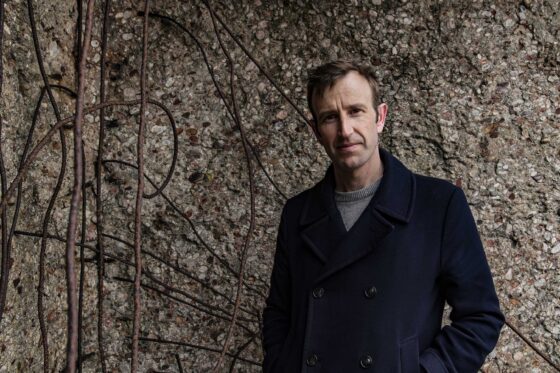
In her latest novel, The Garden (Doubleday Books, 2024), Clare Beams gives us a world of hope, frustration, and senselessness. The protagonist, Irene, is sent to a country estate dedicated to helping women who have trouble bringing a baby to term. Under the watchful eye of a husband-and-wife doctor team, Irene and other women are subject to tests and demands that seem less and less based on medical fact and more on whim.
At the expense of Irene’s sense of control, the doctors try to “rectify the maternal environment.” Rarely is the womb mentioned directly, existing in euphemisms and looked at only out of the corner of one’s eye. The Garden is not a story of villainy. Not really; it is a story where women’s agency is gradually chipped away for the benefit of the doctor’s desire for success.
In that strange in-between condition of motherhood- not-motherhood while a woman is pregnant, how much control do women really have? We hand over the reigns to doctors and experts to tell us how to do it right. Women could not possibly know their own bodies as well. Beyond pregnancy and motherhood, how useful are women anyway? The Garden brings up these questions in an ambient gothic setting complete with jewel-toned medical offices, sprawling mansion hallways, and a walled garden fallen into disrepair. A woman’s body is a house; it is a garden. And also, it isn’t.
I interviewed Beams over email and was excited to get behind-the-scenes into her process while writing The Garden.
***
The Rumpus: Immediately, as I read, I thought of two other references: “The Garden,” a song by Mirah, and a couple of Sharon Olds poems, in particular her series that included “Miscarriage,” “To Our Miscarried One, Age Thirty Now” and “To Our Miscarried One, Age Fifty Now.” How much did other forms of art inform this novel, your inspiration, and/or your process?
Clare Beams: Oh my god! I had somehow never made the connection to that Mirah song, and it is the perfect soundtrack for this novel, down to the way it sort of invades the body as you’re listening, moves you to its own pulse. And I adore Sharon Olds.

Some art I’ll mention: the Finnish photographer Svjetlana Tepavcevic has a series called Means of Reproduction that conjures a feeling like the one I’m chasing in this novel, as does the gorgeous uterus series of Brazilian artist Catharina Suleiman, one piece from which, thanks to extraordinary designer Emily Mahon, ended up on my novel’s cover! And the film Rosemary’s Baby was crucial to me at a point where I’d written a full draft that was almost but not quite leaning into horror and I needed to figure out how to make it lean a little farther.
Rumpus: In our world, we often use euphemisms when we can’t or refuse to face an issue head-on. Bodies have been considered taboo for so long and in many cultures. How intentional was it that you used phrases like “fetal demise,” “crisis,” and “the uterine environment” to describe miscarriage?
Beams: Historically, medical language has been saturated with terms like this, especially when it comes to women’s bodies—technical terms, really, that slide into euphemism by failing to be easily comprehensible to the people whose physical experiences they’re describing. I wanted the doctors in this novel to sound like doctors of their time period, which was my immediate motivation for using this kind of terminology—but on a deeper level I think part of what drew me to write this story in the first place was the question of what unintentional harm can be done behind such screens of language.
Rumpus: I found the duality seen throughout The Garden fascinating: the two doctors; the gown splitting Irene, leaving her both covered and exposed; the symmetry of the house; the use of the words “wait” and “weight,” the idea that Dr. Bishop and Irene look so similar that sometimes they echo each other in some scenes. How intentional was this for you?
Beams: I was doing a lot of conscious playing with doubling and mirroring as I wrote. For a lot of the novel, Irene feels as if she’s carrying both a living baby and a not-living baby, as if both states exist simultaneously, in a way, because she can’t land with lasting certainty on either, and I wanted the language and imagery themselves to sort of multiply disorientingly on the reader so as to capture something of the feel of that state. And the doppelganger-y nature of the relationship between Irene and Dr. Bishop felt important to me, too, mostly as a component of this general mirrored disorientation, but partly too because it felt too easy and too simple to me for Dr. Bishop to be just a villain, entirely separate from Irene. I was chasing a way to write into the bones of the novel, into its imagery, the question of Irene’s own degree of participation in its horrors, I think.
Rumpus: You wrote this so well—how the women in The Garden manage to balance this alive and not-alive in-between existence without going crazy. It came out toward the end in your version of the tree falling in the woods metaphor: “If a woman has a baby, and there’s no one there to see it, and the baby is dead . . . did she have a baby at all? Is she a mother at all?” Can you talk to that a bit?
Beams: Yes! I love how you’ve put this. When writing the line you’ve quoted here, I had a feeling that sometimes comes to me when I’m writing and I’ve finally worked my way to the heart of what I’m doing: Oh, so that’s what I think. I have two children, and I found pregnancy to be such an anxiety-producing state: there were small—or maybe not small, who could tell me, not the doctors, it seemed—abnormalities in each of my pregnancies that either were or weren’t going to work out fine—as happens, I think, pretty often in pregnancy. In the end, things were fine, but the end took a long time coming, and learning to live in that no-man’s-land between hope and fear, for months and months in some cases, wasn’t easy for me, as a person who really likes certainty. Being pregnant put me so fully into my own body, and yet simultaneously what was happening felt so inaccessible to me. I wanted so desperately for everything to be going well in there, and yet I had no way of controlling that at all, or even gauging, really, how it was going, despite the fact that it was all happening inside me. I was aware of living, constantly and intimately, with an enormous life-change—and self-change, the arrival of motherhood—that could either be progressing well or going wildly off the rails at any moment. I wanted to summon an extreme version of that dynamic here, I think.
Rumpus: Irene isn’t very likeable from the beginning, even as her emotions were understandable. What are your opinions on writing likeable versus unlikable protagonists?
Beams: It’s true that Irene isn’t objectively very likeable and also that I love her fiercely and have from the very start. She’s always been much the way she is, on the page. Her state of mind makes a lot of sense to me: she’s a person of enormous, effective will, and yet she most wants this one thing she can’t seem to make her body give her. Her fiercest desire hinges on something she has no control over at all, and she’s trapped, in every way, in a kind of horrible “wait and see.” Her rage feels like a perfectly understandable response to all that, to me anyway. It’s also the case that her anger and disobedience turned out to be very important for the structure of the novel: the situation of the book involves so much stillness and stagnation, with all these women just gathered in this house to kind of wait out their pregnancies, that without a character who was going to really break the rules and move, I think it would have been very difficult to create enough narrative momentum.
I’m passionately committed to the right of unlikeable protagonists to exist—maybe especially unlikeable female protagonists—and to the artistic need for them sometimes. As a writer, you can’t control whether a reader likes your character—or anything about your book, or you!—at all, which has been a hard lesson for me, as a habitual people-pleaser. What you can try to do, I think, is portray the inner life of that character with enough depth and sensitivity that the material is there to allow a reader to invest in that character’s struggles and fate, to care what happens to that character, whether or not the reader likes her. Though you still can’t control whether any given reader will choose to make that investment.
Rumpus: When the women started offing wildlife in the garden, I got some Lord of the Flies vibes. I loved this turn of events, from genteel women-wanting-to-be-mothers to little killers. How did you hold back from turning them into desperate, blood-thirsty monsters? You managed to keep the story from turning into a horror story, despite having elements of it. Did you ever think about making it a bit more horror-genre-esque?
Beams: I love this comparison! I think for me, the key was to make the women intensely, viscerally bloodthirsty and desperate but never allow them to turn into monsters. They don’t want to kill these creatures, but they want what they do want fiercely enough to be willing to take this action if it could get them closer to that end. I suppose I think almost everyone has something in their lives they’d probably kill for and die for—that it’s maybe one of the great tragedies of being human—how our most powerful loves can sometimes make us do our worst things.
The version of the novel that exists is actually one that leans further into horror than earlier versions did. In early drafts, the novel was divided between two point-of-view characters, Irene and Dr. Bishop. But even though Dr. Bishop and her motivations were fascinating to me, it turned out that being in her mind took all the air out of the sails of the ghost story I needed to tell. This is really a novel about pregnancy as a haunted house, and ultimately that meant it had to be Irene’s story, and as soon as I made that happen, the novel took a much darker, more haunted turn. As much fun as some of the horror-infused imagery was to write, though, I think I’m the kind of writer who’s always going to be most interested in the ways a character’s mind is moving, so there was always going to be more of that interiority than any kind of horror special-effects.
Rumpus: Throughout The Garden, when a woman is sent up to the third floor to deliver her baby or succumb to another lost one, you give us short paragraph asides from the point of view of those women. They are told within parentheses. Can you tell me about your choices with this, both why you included them and your stylistic choices there?
Beams: I wrote those sections without really knowing why I was writing them, which is the way a lot of my process works. Looking back, though, I think I just really wanted those characters, even though they aren’t given full points of view in the novel as a whole, to get to voice those moments for themselves. I wanted to let the reader see inside their minds instead of having to infer everything from the outside. It felt like the characters deserved that. I think I wanted those passages to feel a little different in quality and intensity from the rest of the language, which is what’s going on with the parentheses.
Rumpus: You do an incredible job of miring the reader in the senselessness of it all. Without giving anything away, the women later try an experiment out in the garden with the hope that it will affect their pregnancies. To me, a reader, this is absurd, but when in the height of hopelessness and when you’re willing to turn to anything, is it that really that absurd? In the realm of women’s health, we are often told to do X and this will happen. If you don’t do Y, that won’t happen. But often, there are forces beyond our control. Was this a by-product of writing about women’s health, or did you intentionally set out to write about this lack of control?
Beams: Both, absolutely. When I was pregnant, I found myself so susceptible to fervent belief in [and] adherence to absurdities. I vividly remember obsessing for monthsover a cold-cut sandwich I unthinkingly ate while pregnant with my first daughter, forgetting, for just long enough to eat it, that pregnant people aren’t supposed to eat lunchmeat because it can be a carrier for listeria infection, which can, horrifyingly, kill the fetus months later without your ever even knowing anything is wrong. Pregnancy felt stuffed to the gills with things like this, hidden terrors that could spring or not spring. I followed every last rule anyone, especially anyone medically affiliated, even halfway mentioned to me, and I know—I knew even at the time—that I was doing this because I was trying to control the uncontrollable. There was a ritualistic quality to it. In writing about this feeling but crafting a more extreme set of circumstances to showcase it—setting the story back in time, when even less was known and knowable, and when even more of a woman’s life and sense of worth often hung on her completely uncontrollable ability to produce a healthy child—I felt it made sense for these rituals to get still stranger and still more desperate.
Rumpus: I loved the house as a metaphor for a woman’s body. We use metaphor often in literary writing, of course, but they seemed especially apt in this story, working really well to create an ambiance and emotional response for the reader. Do you succumb to over- or under-metaphoring while drafting? Do you take notes on a metaphor you’re going to weave throughout the novel?
Beams: I love, love, love metaphor. To me it feels connected to the heart of fiction: I’m making a whole fantastical thing in order to capture the essence of a real state or feeling, in order to give myself a language for it. I don’t really take notes on my metaphors or plan them out ahead of time. I find my way to them through my often-completely-bonkers early drafts. Then in revision, I have to figure out which of the metaphors I’ve made are actually serving the whole—which are creating a useful and apt language—and which are just kind of embroidery. I prune the second and foster the first. This is one of the many aspects of revision that make it my favorite part of the whole process, because it’s in revision that I get to watch the whole book become itself.
Rumpus: “Maybe all this, now, was some kind of punishment for her failure to ever sew herself nicely into the fabric of things.” And, “She’d had no idea love could swirl with horror that way.” These were my favorite lines and I keep returning to them. On a sentence level, what is your process?
Beams: Thank you! Sentences matter a lot to me, both as a reader and as a writer. By late drafts of my own work, it’s easier for me to embrace adding whole scenes to clarify an aspect of the story, or reworking whole sequences of the action, than to get behind changing actual lines, images, or sometimes even punctuation choices as I’ve written them. It’s not that the sentences are perfect, of course, but that, by that point in the process, they’re mine.
In terms of how the writing itself happens, very little spills out of me in a form that I’d want to show to anybody else. What comes after the initial spillage—messy or clunky or thin or overwrought, but with glimmers of the book’s real self winking at me from out of the mess—is the part where most of the sentences, as they finally stand, get written. The best description I’ve come across of revision, as I experience it—and had been experiencing it long before reading this passage with an eerie feeling of recognition—comes from George Saunders’s A Swim in a Pond in the Rain. He talks about writing [and] revision as a process of endless rereading with a kind of giant internal positive/negative needle on your forehead and never reading past “negative” without making an adjustment in the language. There’s magic to it. It’s the way we can end up writing—over so many small revisitings, made by so many different versions of ourselves—sentences and whole stories that feel wiser than we ourselves do.
***
Author photograph courtesy of Clare Beams




